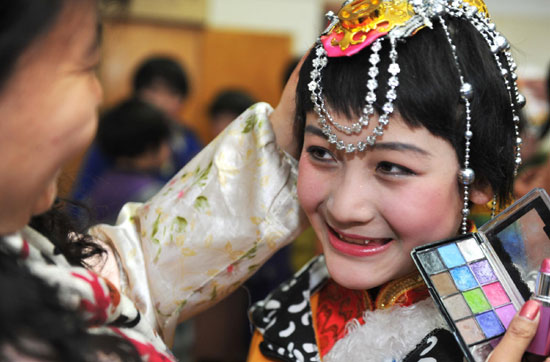
BEIJING - Rigzin Losel is forever grateful for his teachers at the schools in his home county of Nyagqu in Garze, a Tibetan autonomous prefecture in southwest China's Sichuan Province.
Many of them were Han people -- college graduates from big cities who were encouraged by late Chinese leader Mao Zedong to work in remote towns and villages, extend public services and improve the livelihood of the people there.
Thanks to the efforts of these people -- school teachers who taught children to count, read and write; doctors who miraculously saved lives; and agricultural experts who helped local farmers grow grains and vegetables, young Rigzin Losel grew up healthy and literate, and he eventually entered university.
 |
|
A?Tibetan girl dresses up to celebrate Losar, New Year of the Tibetan calender, in Hefei, Anhui province on Feb 22, 2012. [Photo/Xinhua] |
He has followed these people in working for the well-being of the Tibetan people, taking posts as a township and, later, county official before dedicating himself to Tibetan studies in 1986.
When he returned home to Garze for the first time in a decade this year, however, Rigzin Losel saw that grief and uncertainty overshadowed the land and people he loves dearly -- the aftermath of repeated self-immolations by monks, nuns or former clergy members in several Tibetan communities in western China.
"As a Tibetan I was shocked and grieved by the self-immolations," he said. "But, on top of that, I detest those who masterminded this chain of events from behind the scenes."
He was angered by the fact that the 14th Dalai Lama, whom many Tibetans still revere as a "spiritual leader," has praised the "courage" of the self-immolators, instead of denouncing, and calling for an end to, such suicidal acts that deviate from the tenets of Buddhism.
Fifty-three years since fleeing China, the Dalai Lama and his overseas followers have never wavered in their attempt to separate Tibetans from China, said Rigzin Losel.
"The Dalai Lama wants to instigate turbulence and sow the seeds of resentment among the Tibetans," he said. "But for our fellow Tibetans, only stability serves their livelihood."
Investigators have found a striking similarity among the spate of self-immolations in Tibetan areas in the western China provinces of Sichuan, Qinghai and Gansu in recent months: most of the self-immolators had shouted separatist slogans such as "Free Tibet" before setting themselves on fire.
In many cases, photos of the designated self-immolators had been sent in advance to separatist forces abroad, indicating that the self-immolations had been carefully planned.
After each of the tragedies, separatist forces would immediately publish these photos alongside pictures of the self-immolation scenes to play up the situation.
"Tibet independence" groups would notify the press, hoping to launch a media campaign highlighting their one-sided view of the event.
To encourage self-immolations, they even offered compensations for the dead.
But their attempts to create chaos are doomed to fail, as the absolute majority of Tibetans cherish their lives and respect Buddhist teachings.
Tibet Autonomous Region is home to over 1,700 monasteries, and the two Tibetan autonomous prefectures in Sichuan Province, Aba and Garze, have more than 800.
The self-immolators, however, were from just a few monasteries and could not, by any means, represent the will of 5 million Tibetans in China.